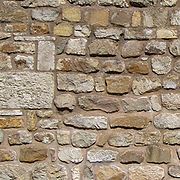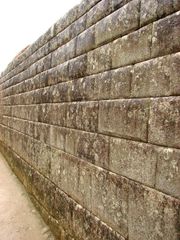Wall

A wall is a usually solid structure that defines and sometimes protects an area. Most commonly, a wall delineates a building and supports its superstructure, separates space in buildings into rooms, or protects or delineates a space in the open air. There are three principal types of structural walls: building walls, exterior boundary walls, and retaining walls.
Contents |
Building walls
Building walls have one main purpose: to support roofs and ceilings. Such walls most often have three or more separate components. In today's construction, a building wall will usually have the structural elements (such as 2×4 studs in a house wall), insulation, and finish elements or surface (such as drywall or panelling). In addition, the wall may house various types of electrical wiring or plumbing. Electrical outlets are usually mounted in walls.
Building walls frequently become works of art externally and internally, such as when featuring mosaic work or when murals are painted on them; or as design foci when they exhibit textures or painted finishes for effect.
On a ship, the walls separating compartments are termed "bulkheads", whilst the thinner walls separating cabins are termed "partitions".
In architecture and civil engineering, the term curtain wall refers to the facade of a building which is not load-bearing but functions as decoration, finish, front, face, or history preservation.
Boundary walls

Boundary walls include privacy walls, boundary-marking walls on property, and town walls. These intergrade into fences; the conventional differentiation is that a fence is of minimal thickness and often is open in nature, while a wall is usually more than a nominal thickness and is completely closed, or opaque. More to the point, if an exterior structure is made of wood or wire, it is generally referred to as a fence, while if it is made of masonry, it is considered a wall. A common term for both is barrier, convenient if it is partly a wall and partly a fence, for example the Berlin Wall. Another kind of wall/fence ambiguity is the ha-ha which is set below ground level, so as not to interrupt a view yet acting as a barrier to cattle for example.
Before the invention of artillery, many of the world's cities and towns, particularly in Europe and Asia, had protective walls (also called town walls or city walls). In fact, the English word "wall" is derived from Latin vallum, which was a type of fortification wall. Since they are no longer relevant for defense, such cities have grown beyond their walls, and many of the walls, or portions thereof, have been torn down, for example in Rome, Italy and in Beijing, China. Examples of protective walls on a much larger scale include the Great Wall of China and Hadrian's Wall.
Separation walls
Some walls are designed to formally separate one population from another. A example was the Berlin Wall, which divided East and West Berlin.
Retaining walls

In areas of rocky soils around the world, farmers have often pulled large quantities of stone out of their fields to make farming easier and have stacked those stones to make walls that either mark the field boundary, or the property boundary, or both.
Retaining walls are a special type of wall, that may be either external to a building or part of a building, that serves to provide a barrier to the movement of earth, stone or water. The ground surface or water on one side of a retaining wall will be noticeably higher than on the other side. A dike is one type of retaining wall, as is a levee, a load-bearing foundation wall, and a sea wall.
Special laws often govern walls shared by neighbouring properties. Typically, one neighbour cannot alter the common wall if it is likely to affect the building or property on the other side. A wall may also separate apartment or hotel rooms from each other. Each wall has two sides and breaking a wall on one side will break the wall on the other side.
Portable walls
Portable walls, such as room dividers or portable partitions, are used to take a large open space and effectively divide it into smaller rooms. Portable walls can be static such as cubicle walls, or they can be wall panels mounted on casters to provide an easy way to reconfigure assembly space. They are often found inside schools, churches, convention centers, hotels and corporate facilities.
Etymology
It is notable that English uses the same word to refer to an external wall, and the internal sides of a room. This is by no means universal, and many languages distinguish between the two. In German, some of this distinction can be seen between Wand and Mauer, in Spanish between pared and muro.
Walls in popular culture
In culture a wall normally means a barrier stopping progress or entry. For instance the progressive / psychedelic rock band Pink Floyd have a concept album called The Wall. This Wall is not real, but a metaphor for social barring. American poet laureate Robert Frost describes a pointless rock wall as a metaphor for the myopia of the culture-bound in his poem Mending Wall. The Berlin Wall that separated the Soviet zone of Berlin, Germany from the rest of the city from 1961 until its ultimate destruction in 1989 was often referred to just as 'The Wall'.
In some cases, a wall may refer to an individual's debilitating mental or physical condition, seen as an impassable barrier.
Another common usage is as a communal surface to write upon. For instance the social networking site Facebook uses a wall to log the scrawls of friends. Users have gone on to create more advanced versions of the original wall, such as the application SuperWall.
See also
- List of walls
- Ashlar
- Curtain wall
- Dry-stone wall
- Fence
- Load-bearing wall
- Sleeper wall
- Stone wall
- Wallpaper